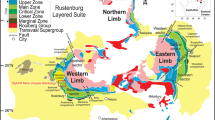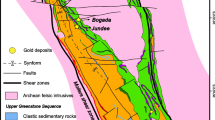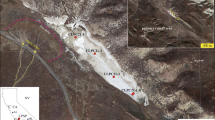Abstract
Pyroclastic cones along the southwest coast of Mauna Loa volcano, Hawai'i, have a common structure: (a) an early formed circular outer rim 200–400 m in diameter composed mostly of scoria and lapilli, and (b) one or more later-formed inner rims composed almost exclusively of dense spatter. The spatter activity locally fed short lava flows that ponded within the outer rims. Based on various lines of evidence, these cones are littoral in origin: relationships between the cones and associated flows; the degassed nature of the pyroclasts; and (although not unequivocal) the position of the cones relative to known eruptive vent locations on Mauna Loa. Additional support for the littoral interpretation comes from their similarity to (smaller) littoral cones that have been observed forming during the ongoing Kilauea eruption. The structure of these Mauna Loa cones, however, contrasts with that of “standard” Hawaiian littoral cones in that there is (or once was) a complete circle of pyroclastic deposits. Furthermore, they are large even though associated with tubefed pāhoehoe flows instead of 'a'ā. The following origin is proposed: An initial flow of tube-fed pāhoehoe into the ocean built a lava delta with a base of hyaloclastite. Collapse of an inland portion of the active tube into the underlying wet hyaloclastites or a water-filled void allowed sufficient mixing of water and liquid lava to generate strong explosions. These explosions broke through the top of the flow and built up the outer scoria/lapilli rims on the solid carapace of the lava delta. Eventually, the supply of water diminished, the explosions declined in intensity to spattering, and the initial rim was filled with spatter and lava.
Similar content being viewed by others
References
Brigham WT (1909) The volcanoes of Kilauea and Mauna Loa. Mem of the Bernice Pauahi Bishop Museum of Polynesian Ethnology and Natural History 2, 4:222 pp
Cas RAF, Wright JV (1988) Volcanic Successions. Ulwin Hyman, London
Clague DA, Dalrymple GB (1987) The Hawaiian-Emperor volcanic chain Part 1: geologic evolution. US Geol Surv Prof Pap 1350:5–54
Fisher RV (1968) Pu'u Hou littoral cones, Hawaii. Geol Rundschau 57:837–864
Fisher RV, Schmincke H-U (1984) Pyroclastic rocks. Springer, Berlin Heidelberg New York
Heliker CC, Wright TL (1991) The Pu'u 'O'o-Kupaianaha eruption of Kilauea. EOS 72:521–530
Kauahikaua J, Denlinger R, Foster J, Keszthelyi L (1993) Lava delta instability: is it mass-wasting or is it triggered by lava flowing through tubes? EOS 74 (43) (Suppl):616
Jaggar TA (1919) Monthly Bulletin of the Hawaiian Volcano Observatory 7:121–173
Jurado-Chichay Z (1993) The Pohue Bay flow, Mauna Loa Hawaii: high volumetric flow-rate tube-fed pahoehoe and associated features. Master's thesis, Univ Hawaii:117 pp
Jurado-Chichay Z, Rowland SK (1995) Channel overflows of the Pōhue Bay flow, Mauna Loa, Hawai'i: examples of the contrast between surface and interior lava. Bull Volcanol 57:117–126
Jurado Z, Rowland SK, Walker GPL (1991) Littoral cones of the Pu'u Ki area, Hawaii: high-intensity explosions from major pahoehoe lava tubes. EOS 72 (44):566
Jurado-Chichay Z, Urrutia-Fucugauchi J, Rowland SK (1996) A paleomagnetic study of the Pōhue Bay flow and its associated coastal cones, Mauna Loa Volcano, Hawai'i: constraints on their origin and temporal relationships. Phys Earth Planet Interiors (in press)
Lipman PW (1980a) The southwest rift zone of Mauna Loa — implications for structural evolution of Hawaiian volcanoes. Am J Sci 280-A:752–776
Lipman PW (1980b) Rates of volcanic activity along the southwest rift zone of Mauna Loa Volcano, Hawaii. Bull Volcanol 43:703–725
Lipman PW, Swenson A (1984) Generalized geologic map of the southwest rift zone of Mauna Loa Volcano, Hawaii. US Geol Surv Misc Investig Ser Map I-1323
Lockwood JP, Lipman PW (1987) Holocene eruptive history of Mauna Loa volcano. US Geol Surv Prof Pap 1350:509–535
Macdonald GA (1972) Volcanoes. Prentice-Hall, Englewood Cliffs, NJ
Macdonald GA, Abbott AT, Peterson FL (1983) Volcanoes in the sea, The geology of Hawaii. University of Hawaii Press, Honolulu
Mangan M, Cashman K (1992) Vesiculation of basaltic magma during eruptions-low energy versus high energy events. EOS 73 (43) (Suppl):629
Mattox TN (1993) Hydrovolcanic explosive activity where lava meets the sea, Kilauea Volcano, Hawaii. EOS 74 (43) (Suppl):616
Mattox TN (1994) Where lava meets the sea: Kilauea Volcano, Hawai'i. Earthquakes Volcanoes 24:160–177
Mattox TN, Heliker C, Kauahikaua J, Hon K (1993) Development of the 1990 Kalapana flow field, Kilauea Volcano, Hawaii. Bull Volcanol 55:407–413
Moore JG, Ault WU (1965) Historic littoral cones in Hawaii. Pac Sci 19:3–11
Moore JG, Fabbi BP (1971) An estimate of the juvenile sulfur content of basalt. Contrib Mineral Petrol 33:118–127
Moore JG, Phillips RL, Grigg RW, Peterson DW, Swanson DA (1973) Flow of lava into the sea, 1969–71, Kilauea Volcano, Hawaii. Bull Geol Soc Am 84:537–546
Moore JG, Fornari DJ, Clague DA (1985) Basalts from the 1877 submarine eruption of Mauna Loa, Hawaii: new data on the variation of palagonitization rate with temperature. US Geol Surv Bull 1663:11 pp
Morrissey MM (1990) Application of results from Fe−Al melt-water explosion experiments to hydrovolcanic eruptions. Unpubl MS thesis, Univ of Texas, Arlington, 137 pp
Morrissey MM, Thordarson T (1991) Origin and occurrence of pseudocrater fields in southern Iceland. EOS 72 (44):566
Peterson DW (1976) Processes of volcanic island growth, Kilauea Volcano, Hawaii, 1969–1973. In: Gonzales-Ferran (ed) Proc Symp Andean and Antarctic Volcanology Problems (Santiago, Chile, Sept. 1974). IAVCEI special series:172–189
Rowland SK, Walker GPL (1990) Pahoehoe and a'a in Hawaii: volumetric flow rate controls the lava structure. Bull Volcanol 52:615–628
Sansone FJ, Resing JA (1991a) Lava-seawater interactions and the resultant steam plume at Wahaula, Hawaii. EOS 72 (44):566
Sansone FJ, Resing JA (1991b) Nearshore lave-seawater interactions at Wahaula, Hawaii, 1990–1991: the effects of intensified lava input to the ocean. EOS 72 (44):558
Sakai H, Casadevall TJ, Moore JG (1982) Chemistry and isotope ratios of sulfur in basalts and volcanic gases at Kilauea volcano, Hawaii. Geochim Cosmochim Acta 46:729–738
Stearns HT, Macdonald GA (1946) Geology and ground-water resources of the island of Hawaii. Hawaii Div Hydrogr Bull 9:363 pp
Swanson DA, Fabbi BP (1973) Loss of volatiles during fountaining and flowage of basaltic lava at Kilauea volcano, Hawaii. US Geol Surv J Res 1:649–658
Thordarson T, Self S (1991) Lava-seawater interaction at the Kupainanaha flow front, Kilauea Volcano, Hawaii. EOS 72 (44):566
Thordarson T, Self S (1993) The Laki (Skaftar fires) and Grimsvotn eruptions in 1783–85. Bull Volcanol 55:233–263
Walker GPL (1991) Structure and origin by injection of lava under surface crust of tumuli, “lava rises”, “lava-rise pits”, and “lava inflation clefts” in Hawaii. Bull Volcanol 53:546–558
Walker GPL (1992) Puu Mahana near South Point in Hawaii is a primary Surtseyan ash ring, not a littoral cone. Pac Sci 46:1–10
Wohletz KH (1983) Mechanisms of hydrovolcanic pyroclast formation: grain size, scanning electron microscopy and experimental studies. J Volcanol Geotherm Res 17:31–63
Author information
Authors and Affiliations
Rights and permissions
About this article
Cite this article
Jurado-Chichay, Z., Rowland, S.K. & Walker, G.P.L. The formation of circular littoral cones from tube-fed pāhoehoe: Mauna Loa, Hawai'i. Bull Volcanol 57, 471–482 (1996). https://doi.org/10.1007/BF00304433
Received:
Accepted:
Issue Date:
DOI: https://doi.org/10.1007/BF00304433




